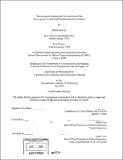| dc.contributor.advisor | Frank Levy. | en_US |
| dc.contributor.author | Srinivas, Smita | en_US |
| dc.contributor.other | Massachusetts Institute of Technology. Dept. of Urban Studies and Planning. | en_US |
| dc.date.accessioned | 2005-06-02T18:22:57Z | |
| dc.date.available | 2005-06-02T18:22:57Z | |
| dc.date.copyright | 2004 | en_US |
| dc.date.issued | 2004 | en_US |
| dc.identifier.uri | http://hdl.handle.net/1721.1/17719 | |
| dc.description | Thesis (Ph. D.)--Massachusetts Institute of Technology, Dept. of Urban Studies and Planning, 2004. | en_US |
| dc.description | Includes bibliographical references (p. 216-227). | en_US |
| dc.description.abstract | The Indian pharmaceutical and biopharmaceutical sectors have been characterised by three features considered analogous to technological stagnation: low R&D investments, "copying" on-patent drugs (legal in India if a novel process is found) and manufacturing off-patent, generic drugs. Yet, some firms are innovating in drug discovery and development and the total number of firms is among the most numerous and export-oriented in the developing world. This dissertation looks at patterns of technological capabilities using sector-wide indicators and firm-level cases in synthetic and biological pharmaceuticals. Common explanations for the sectoral capabilities are the country's process patent regime. However, a more detailed analysis shows this cannot be the sole cause. Although the patent regime was critical in helping firms develop skills early on, their process capabilities were honed by a variety of selection environments, of which the patent regime was one type. There were at least three distinct selection environments and at least three broad types of associated learning. The findings of external environmental influence and selection do not weaken the importance of national policy, far from it. However, studies that assign explanatory power for the sectors' advance entirely to national patent policies or rational firms miss the significance of the Indian story to date. The research also shows that there is scope for broadening debates on public health medicines to address technological learning opportunities in developing countries. | en_US |
| dc.description.statementofresponsibility | by Smita Srinivas. | en_US |
| dc.format.extent | 227 p. | en_US |
| dc.format.extent | 12782862 bytes | |
| dc.format.extent | 12782670 bytes | |
| dc.format.mimetype | application/pdf | |
| dc.format.mimetype | application/pdf | |
| dc.language.iso | eng | en_US |
| dc.publisher | Massachusetts Institute of Technology | en_US |
| dc.rights | M.I.T. theses are protected by copyright. They may be viewed from this source for any purpose, but reproduction or distribution in any format is prohibited without written permission. See provided URL for inquiries about permission. | en_US |
| dc.rights.uri | http://dspace.mit.edu/handle/1721.1/7582 | |
| dc.subject | Urban Studies and Planning. | en_US |
| dc.title | Technological learning and the evolution of the Indian pharmaceutical and biopharmaceutical sectors | en_US |
| dc.type | Thesis | en_US |
| dc.description.degree | Ph.D. | en_US |
| dc.contributor.department | Massachusetts Institute of Technology. Department of Urban Studies and Planning | |
| dc.identifier.oclc | 56429681 | en_US |
